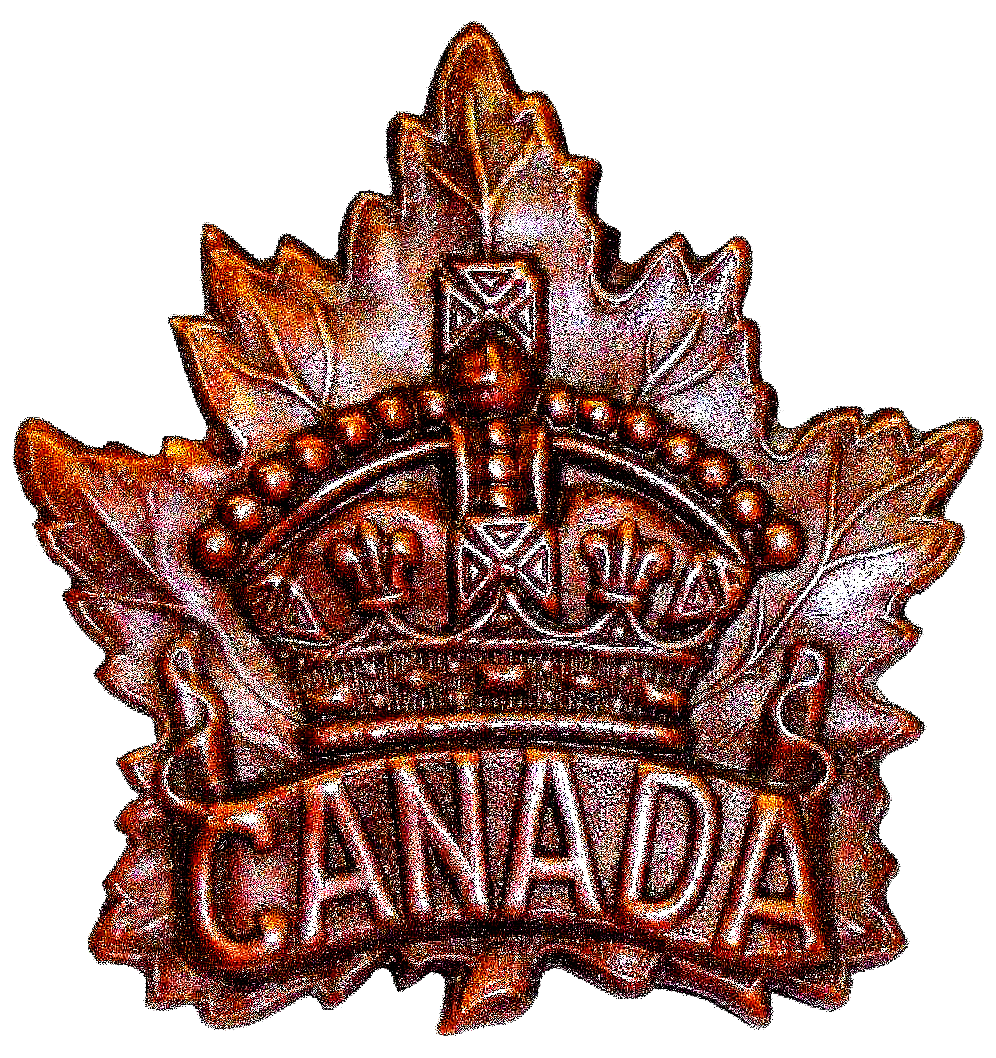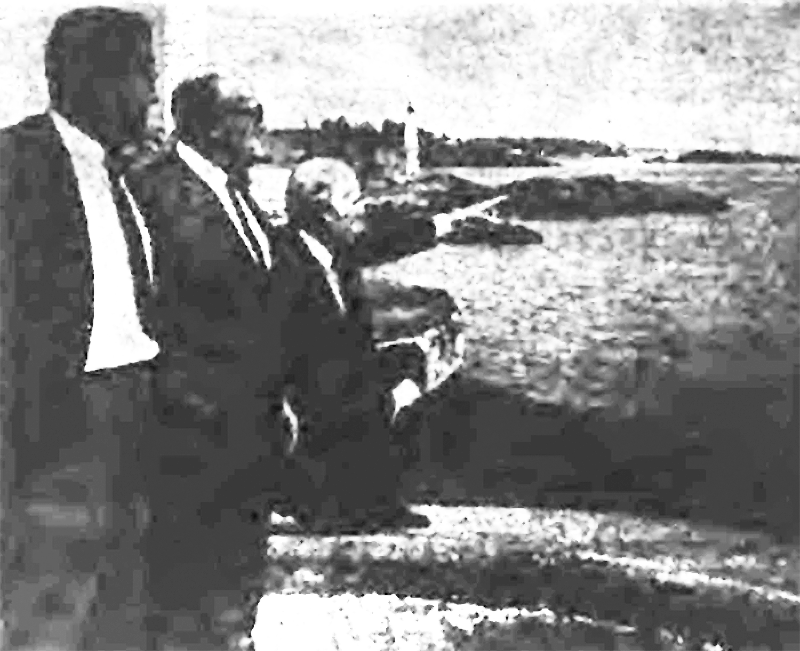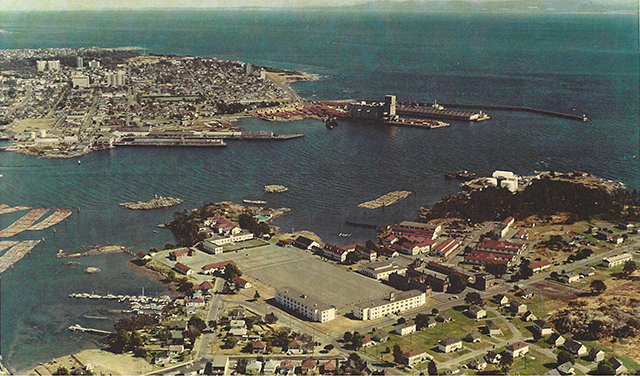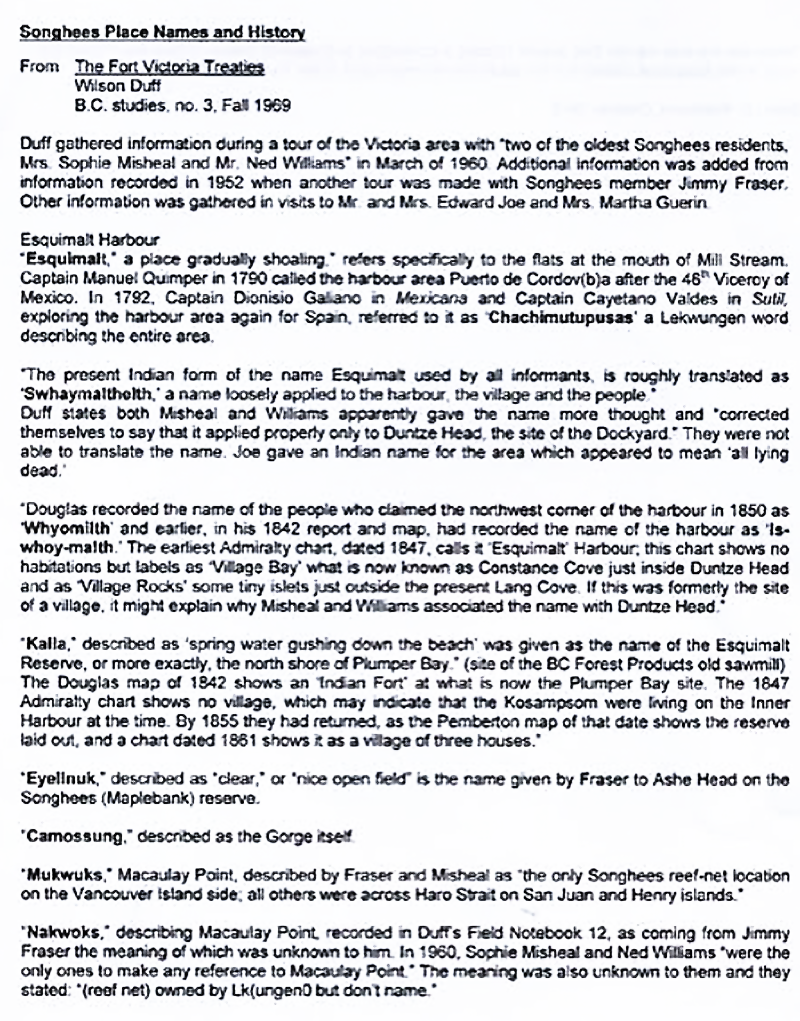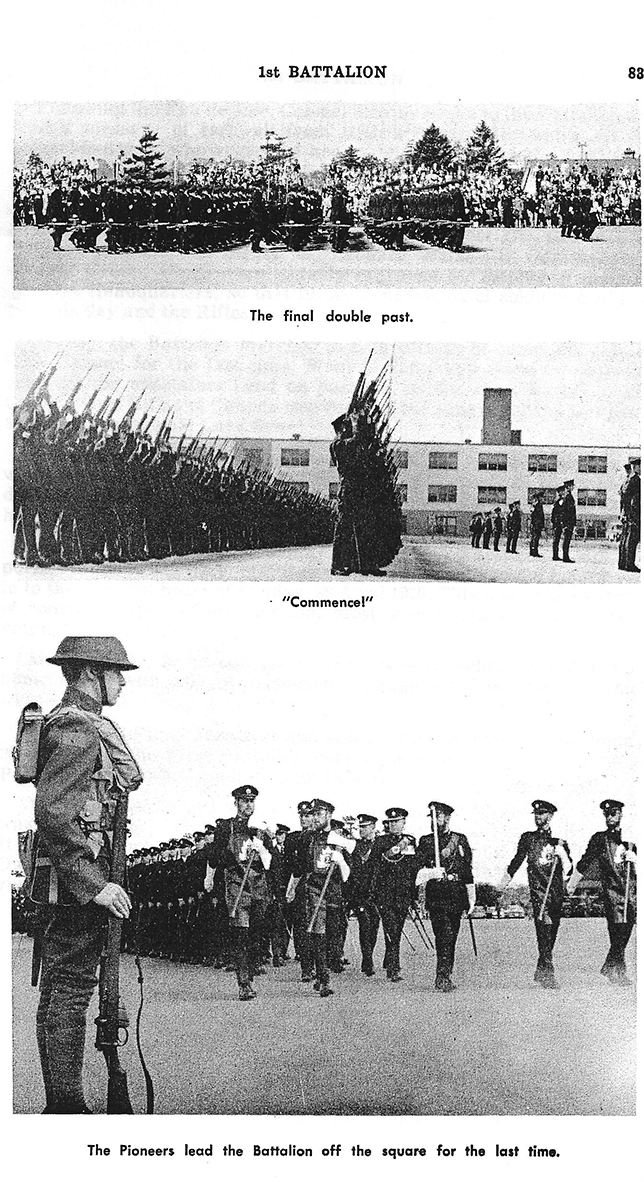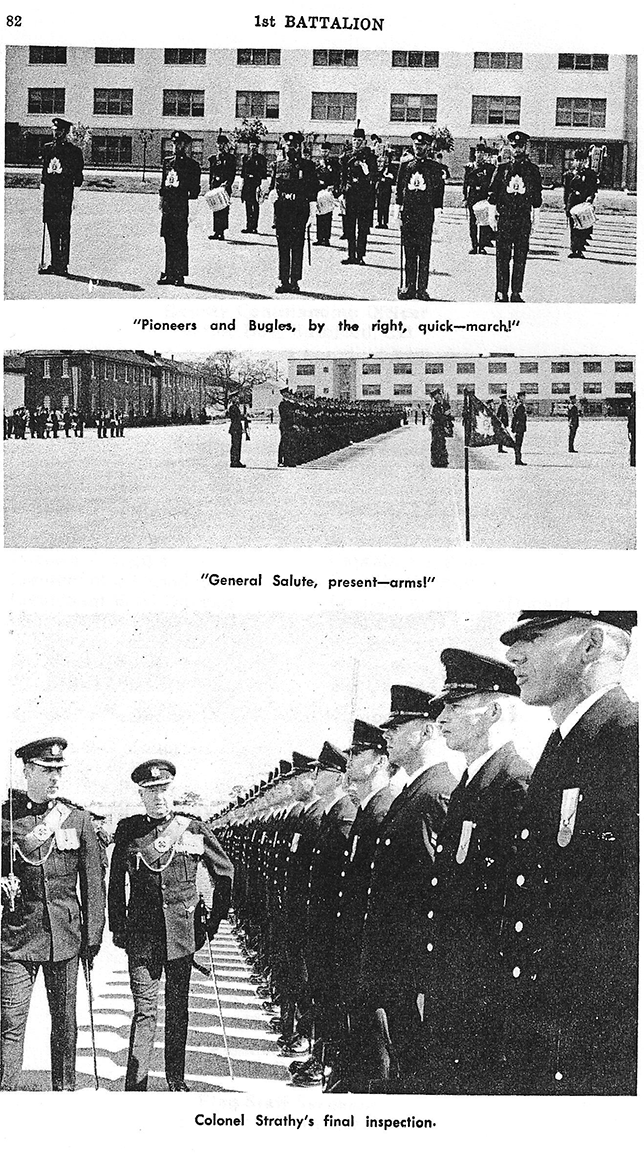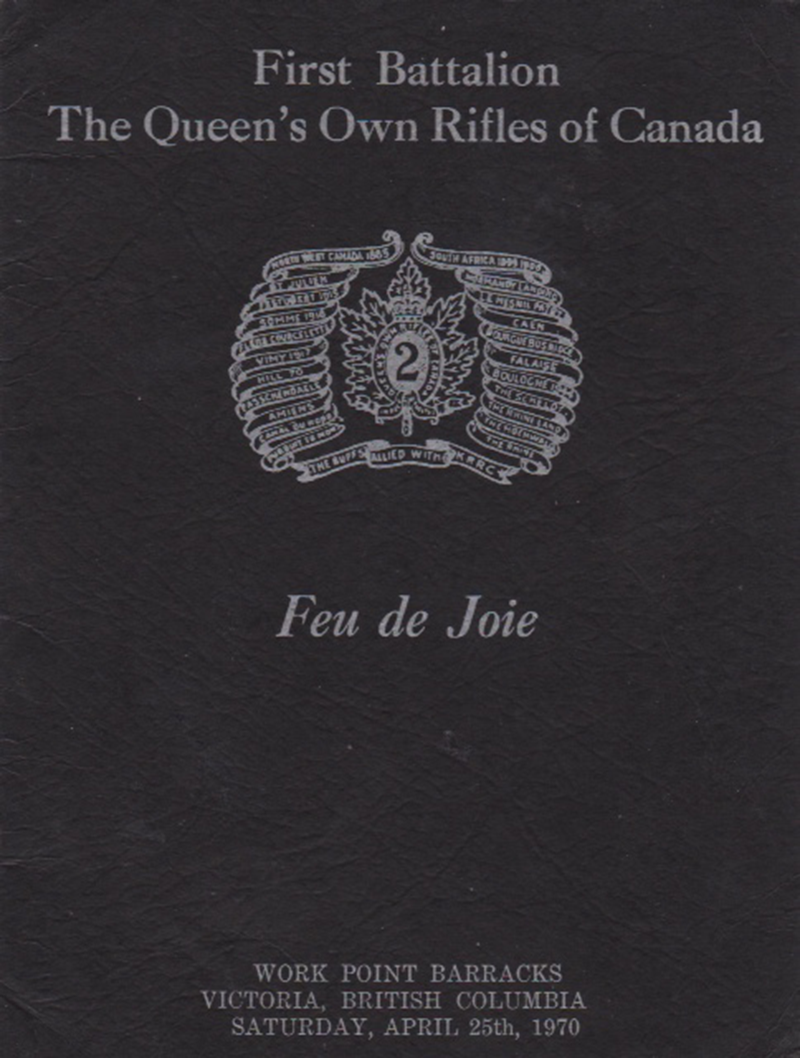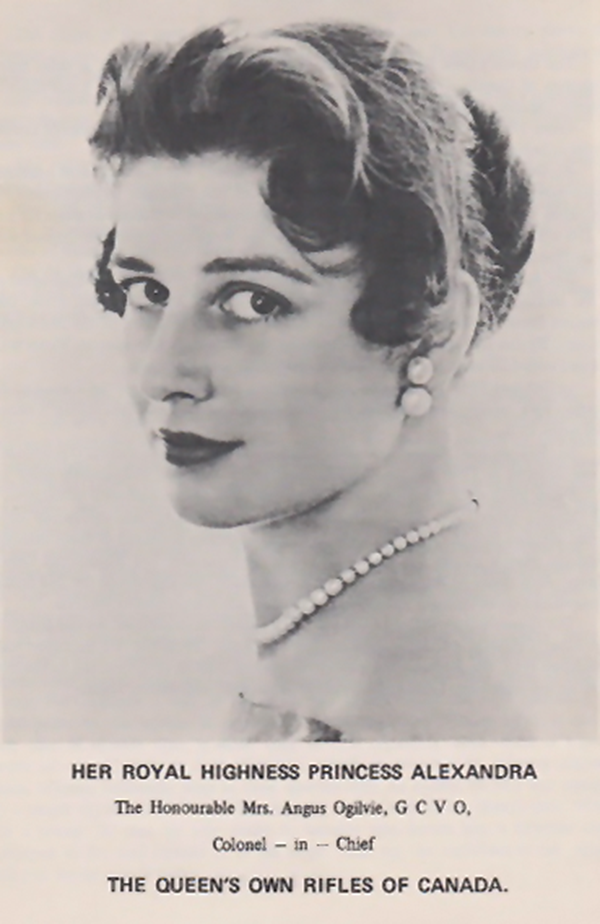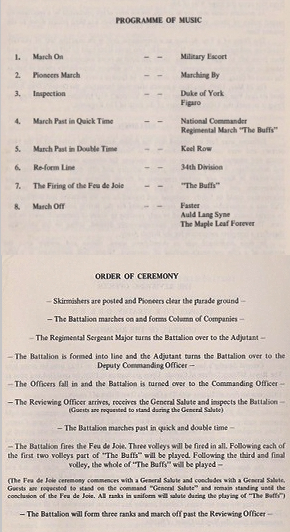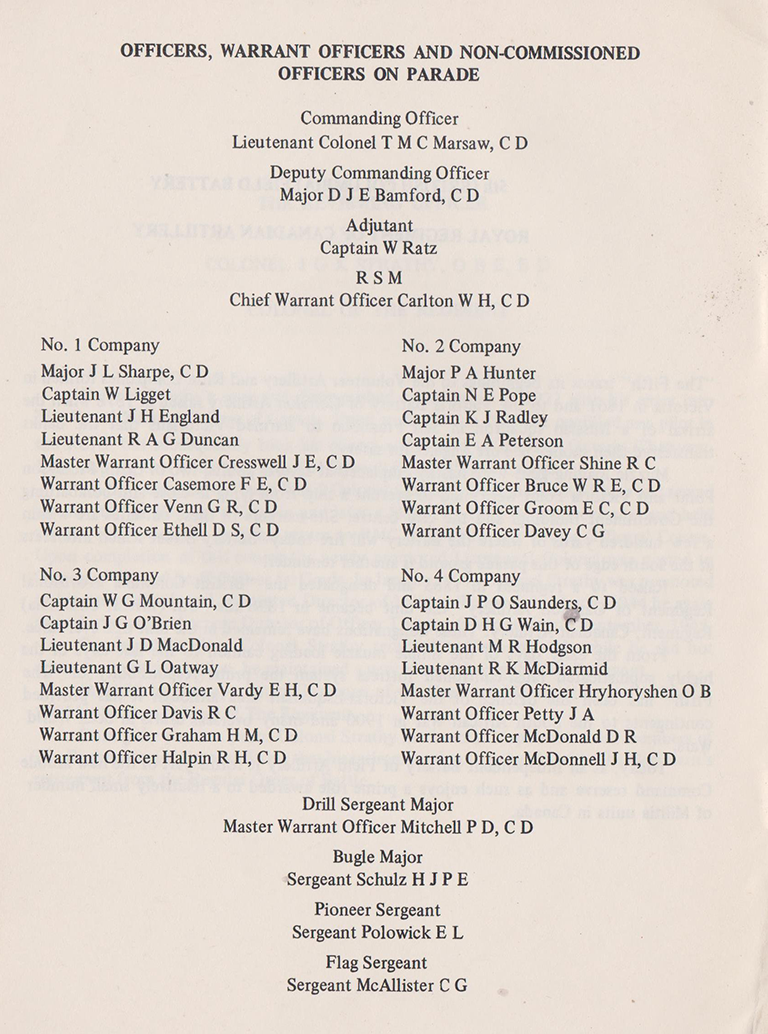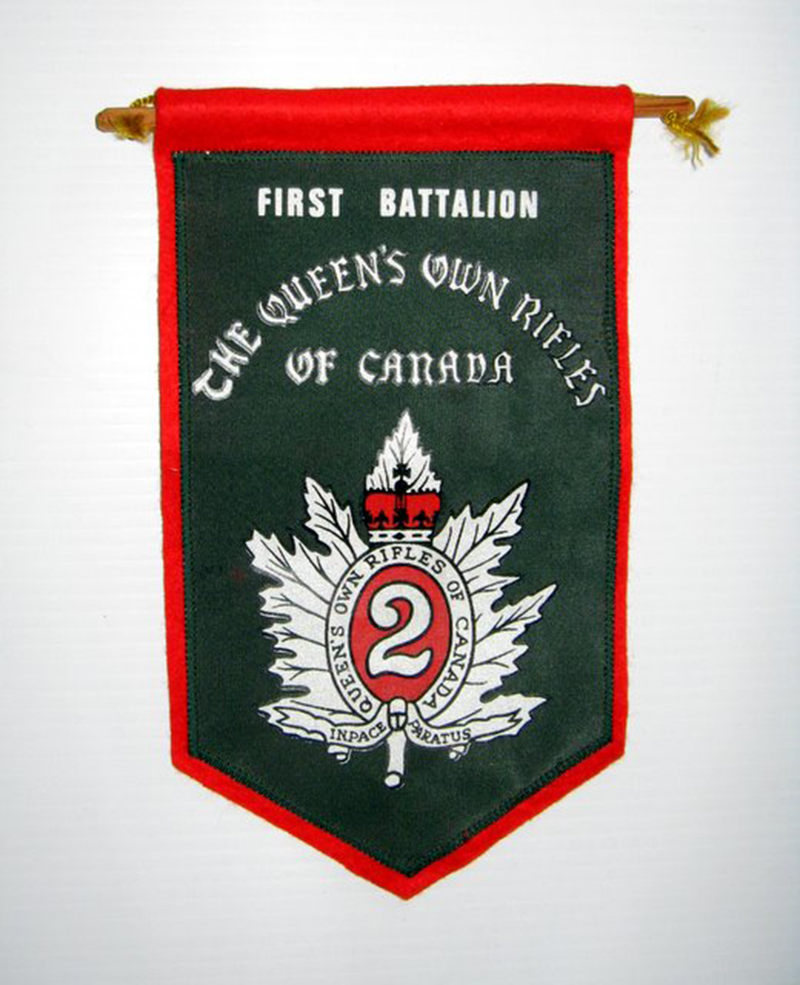 |
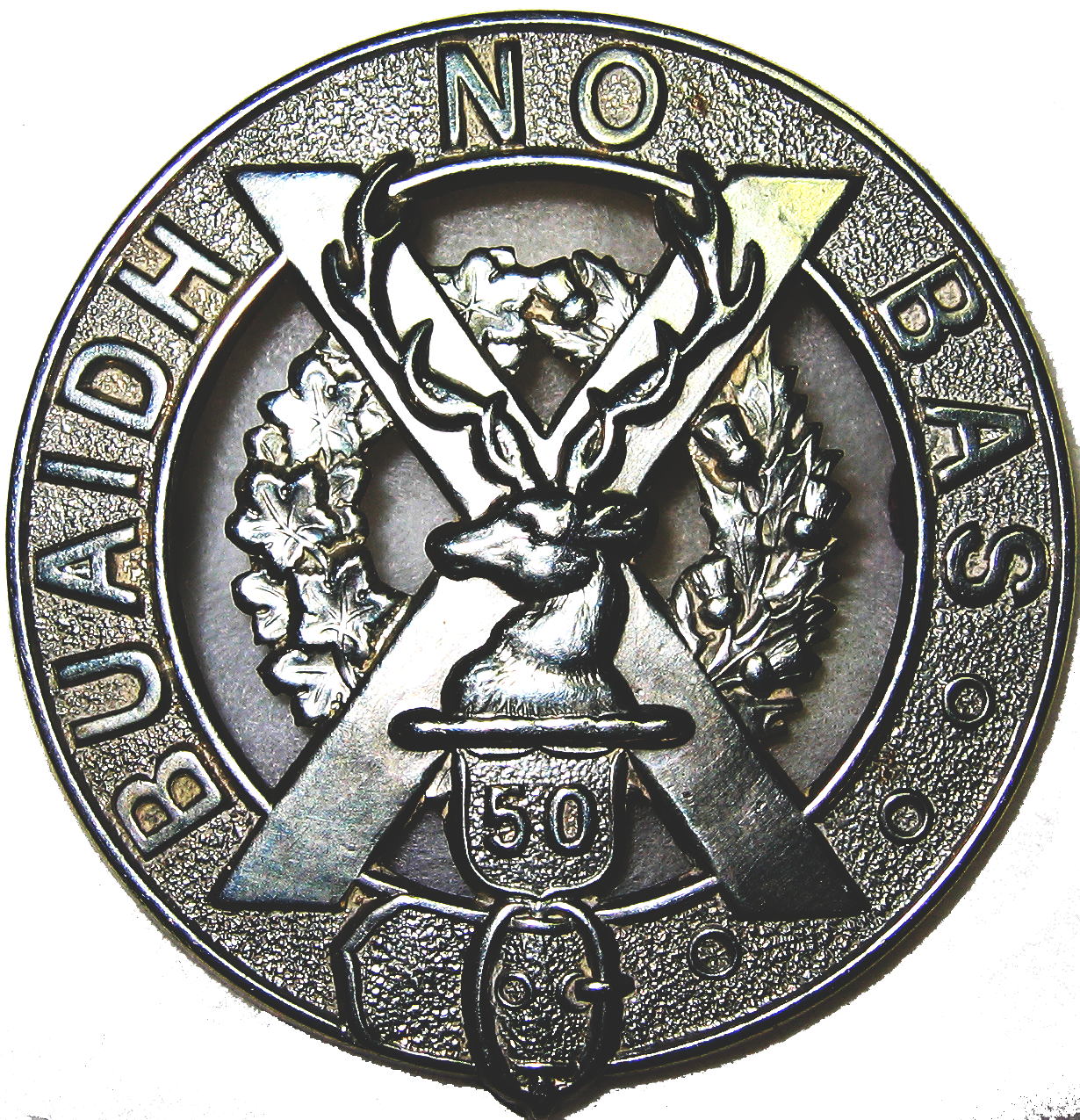 OPCMHVisitor No.: |
HISTORY OF WORK POINT BARRACKSby Jack BatesPART 8 — 1964 to 19701969Powder Horn BATTALION LIFE – ACTIVITIES AND PERSONALITIES INTEGRATION ‘N SALTY TALES ‘N ALL THAT When one stops to consider that the Regimental Home Station sits on the biggest ocean in the world, and is also a lodger unit on a Maritime Command base, a bit of Naval terminology can be expected to creep into our vocabulary. The February ’69 fire in the Motor Transport building provoked the following broadside from the Co: OPERATIONAL IMMEDIATE 161500Z JUN 69 FM 1 QOR OF C ESQUIMALT Base, undaunted, replied with:
Who says the Pacific branch of the Army of the west isn’t bilingual? We speak English and Navy! REDEDICATION OF THE BOOK OF REMEMBRANCE During a simple but impressive ceremony conducted at the Service on Sunday, 16 March 1969 in St. Barbara’s Chapel, The Queen’s Own Rifles of Canada Book of Remembrance 1866 – 1918; was rededicated and the Regimental and 1st Battalion flags were installed in the chapel to commemorate the relocation of the Regimental Home Station to Work Point Barracks, Victoria. BATTALION HOCKEY TEAM 69-70 The familiar chant of “GO RIFLES GO! GO RIFLES GO!” echoed through the rafters of the Esquimalt Arena for the last time, as our team played its last season with the Vancouver Island Hockey League. BATTALION BUGLES The Battalion Bugles look forward to another busy, challenging year when they become the Corps of Drums of 3 PPCLI and slow down to 120 paces to the minute. “Three Blind Mice” became a regular theme song when the Bugles played for Rifles hockey games at Esquimalt arena; which was thoroughly enjoyed by the players, spectators and most of the referees. CHANGE OF COMMAND PARADE On Friday, 28 March 1969, a ceremonial parade was held at Work Point Barracks to say farewell to L Col HC Pitts, MC, CD, and to welcome the new Commanding officer, L Col TMC Marsaw, CD. Lt Col Pitts assumed command of the battalion in January 1967 and had a most hectic tour of duty. During 1967 the unit was involved in many Centennial activities and in 1968 was heavily engaged in training and exercises as part of the ACE Mobile Force (Land). L Col Pitts left us for a most demanding and important position at the US Army Command and General Staff College at Fort Leavenworth, Kansas. As they had become accustomed, the Regiment performed the Feu de Joie on July 1st at Beacon Hill Park, and the Victoria May Day parade in the City of Victoria providing a 120 man guard, the Bugles, 3 APC’s, a pair of 106’s and a tabloid float. They also provided a 50 man guard for the June 21st Buccaneer Days in Esquimalt and for Remembrance Day, provided a 31 man guard for each of the services held in Esquimalt and Victoria. Photo July 3, 1969 Rear Rank on Holiday Rear ranks look little ragged compared with precise positions of Queen’s Own Rifles in Beacon Hill Park. Regiment and 5th Field Battery, RCA (militia), performed feu des joie as part of Dominion Day celebration on Tuesday, and 21-gun salute followed drill. Other holiday events included a 12-hour rock music festival and 10-mile walkathon around Oak Bay. The battalion trained in Wainwright as well in 1969. Daily Colonist “CIVILIANS” MANNED COAST GUNS SIX HOURS AFTER ARMY CALLUP Two of the hundreds who forsook “civvies” for khaki on that historic afternoon 30 years ago are insurance agent C.M. “Chuck” MacLeod and high school teacher, Geoffrey D’Arcy. Three decades later, both men vividly remember the excitement attending the dramatic event. This is an excellent article written by well-known Vancouver Island author T.W. Paterson, with photographs, telling the tale of the militia manning the guns at Fort Rodd Hill in August of 1939. Included are references from Jack Rippengale, a gunner at the time, who became Superintendent of the Fort Rodd Hill National Park in 1965. Chuck MacLeod had been at work that morning, when, “for some reason or other, I phoned home to my mother and she said she’d had a phone call from the 5th to say that I should report to the Bay Street Armouries at three in the afternoon in preparation to move out to Fort Rodd Hill.” A sergeant in the 60th Battery of the 5th B.C. Coast Brigade, he had hurried home, changed into uniform, and reported to the armoury. There, he met his younger brother, BSM Don MacLeod, with the rest of his battery. “There was quite a bit of confusion; in fact, utter confusion,” Mr. MacLeod recalls, “and of course, there was a great deal of excitement.” Like many others, Geoff D’Arcy had been on vacation when ordered to report. Also of the 60th ANTB – anti-motor torpedo boat battery – the lieutenant had fallen in with his battery at 3 p.m. Due to the rapidly worsening international situation, the emergency order had not come as a complete surprise to militiamen, although one does not have to be a member of today’s reserves to imagine going to work in the morning as usual, and being ordered to report for active duty that afternoon. “We had actually been anticipating something happening,” said Mr. MacLeod. “I attended the Royal School at Macaulay, and qualified as a sergeant; this was in the spring of 1939.” “In fact, I think my brother was on my tail all the time to qualify. He’d been in the militia in the NPAM, the non – permanent active militia, and he’d been in a number of years ahead of me and he realized that something would happen and that we had to get qualified quickly so we could man the forts when needed.” The 55th Battery, under Maj. Russell Ker, took command of the new 6-inch coastal defence guns at Mary Hill; nearby was the Brigade HQ under Lt. Col. Vincent McKenna, CO; the 9.2-inch counter bombardment artillery of Albert head was manned by the 56th Battery, Maj. Sid Bowden commanding. From Brotchie Ledge to Mary Hill, members of the 17th Searchlight Battery (formerly the Engineers) manned their stations, with Battery HQ at Rodd Hill, commanded by Maj. J.H. McIntosh. Also on duty at Macaulay was the 2nd Anti – Aircraft Battery, Maj. Robert Phipps. At 6 p.m., the 60th, under Maj. Carl Gonnason, recalled to industry almost immediately and replaced by Maj. “Denny Diespecker, had marched into Fort Rodd Hill to assume command from a squad of the 5th Heavy Battery, RCA, known as the outfort detachments, or “District Gunners.” The 60th was also responsible for Belmont Battery’s two 12 pounders and those of Black Rock Battery across the harbor. The role of the permanent force had been that of maintaining coastal defences. “Keeping everything in shape, making sure the ammunition was fit to be used, that the guns were ready for their operational role and instructing the militia.” One of the regulars on duty at Fort Rod Hill was a young gunner named Jack Rippengale, whom we shall meet later. Immediately upon the militia’s arrival, gun crews had been assigned, watches scheduled, the artillery armed, - “those guns were never unloaded from that day on” – and tents erected as the fort lacked sufficient quarters for the influx of personnel. By 9 a.m., Fort Rodd Hill was ready for action under command of the 5th B.C. Coast Brigade – whose officers and men, but six hours before, had been civilians, going about their everyday routines. “It was a beautiful summer evening,” Geoff D’Arcy recalled. A militiaman since 11926, the senior lieutenant had been with the 60th ANTB since its inception, two years earlier. Belmont Battery, assigned examination duty, was placed under his command. An inventory of ammunition had disclosed 600 rounds on hand at the fort, - including two boxes of case – shot dated about 1887. “This meant,” explained Mr. Darcy, as we thought at the time, that we could at least give an account of ourselves.” “But the very next day, a truck came from District HQ and loaded up all but 40 – 50 rounds. Meaning that, at most, we could fire 1 ½ minutes!” The battery had quickly established a routine. One of the more pressing duties during this hectic period was the 11th hour training of gun crews. So busy in fact, were most NCO’s that they did not find time to fill out the forms officially placing them on active service. This led to the incongruity of Sgt. MacLeod, “training people who subsequently had longer war service than I had because they didn’t get around to swearing us in until sometime about the first of September. “We were there, on duty, training people who were taken on as they walked into the fort through the orderly room. Meaning they actually were on strength longer than I was.” A down – to – business spirit prevailed at the coastal batteries; there was no question of being on manoeuvres. “Once the unit was called out, all games ceased. This was deadly serious from that moment forward, deadly serious.” Emphasizing the gravity of the situation was the fact the militiamen received only one day’s leave in six, gun crews standing three watches: duty, reserve and off. “Most of us lived close enough that we could practically wave to our families. But we weren’t allowed to communicate with them when on duty. This was it, the real thing.” There had been practice alarms – at 2 and 3 a.m. Not that the militiamen had lacked lighter moments, - like that Saturday afternoon Belmont Battery wrote a page in military history. Tragically, their moment of glory has been allowed to fade from memory. Belmont’s duty as examination battery was to assist an examination vessel, on patrol between Victoria and Esquimalt Harbors. All incoming vessels, regardless of size or occupation, including service vessels, had to display the correct signals: flags by day, specially designated red and green lights by night. Lieut. D’Arcy was off watch that momentous afternoon a ship ignored the examination vessel. On duty was Lieut. Bob Love and Sgt. Chuck MacLeod. “If a vessel avoided the examination vessel or failed to report,” he explained, “And moved in without identifying itself properly, the duty of the gun crew was well known. It’s called “bring to” procedure, which meant that you would fire a shot across the bow of the ship so it would stop.” In this incident, the examination vessel was cruising at the entrance to Victoria Harbor at the time an RCN harbor craft returned from Royal Roads. Rather than wait for clearance, the unidentified captain had headed straight into Esquimalt. Lieut. Love’s answer to this effrontery had been to order hid crew to lay a shot across the craft’s bow. “It was quite impressive,” chuckled Mr. MacLeod. “Those 12 pounders, you know, made quite a splash.” “Obviously, we were quite excited about it because we knew there’d be some repercussion because you don’t do that to the navy.” After the {inevitable” heated exchange between the navy and the battery, a conference was hastily called. The meeting resulted, within 24 hours, in the “examination service being affectively in operation.” It is to be noted that protocol in such a situation demanded the chastened master pay for the cost of the round as penalty. Laughed Mr. MacLeod: “I think that one was on us.” Thus concluded Belmont Battery’s claim to fame: that sunny afternoon of 30 years ago when it fired one of the first shots of the Second World War – at the Royal Canadian Navy! Another later incident involving the examination vessel also involved Sgt. MacLeod. But this time a 12 pounder from Macaulay Point had been mounted at the end of Ogden Point breakwater. Living in barracks built on the harbor side of the seawall, the gun crews stood watches of eight hours on duty, eight hours off. Because they were so near town, those off duty were given liberty. At night an officer had to be present, but during the day Sgt. MacLeod was in command. “As time went on, ships began to try to dodge the examination vessel because he, having to guard both ports, if you will, sometimes had to lay far off and it sometimes meant quite a detour for a ship. “I remember one afternoon, a fishing boat came close in to Brotchie Ledge, purposely going out of its way to avoid reporting to the examination vessel. “Well, we just sort of waited till the boat was right below us. The first thing that fellow saw as he came out of his cabin, he was looking down the barrel of this 12-pounder as we threw a dummy round in and went through the procedure of load. And, believe you me, he stopped pretty fast.” For a 21-year-old gunner Jack Rippengale, on duty at Fort Rodd Hill with the 5th Heavy Battery when the militia assumed command August 26, 1939, fate has come full cycle. Now superintendent on Fort Rodd Hill National Park, the retired army captain had enlisted there in 1937. “Each year,” he recalled, “the 5th Heavy Battery moved from normal quarters in Work Point Barracks for six to eight weeks of intensified training at Fort Rodd Hill. “Known as summer camp, this period was always a highlight of the years as it included our annual gun practice. We were at the tail end of summer camp 1939 when the precautionary period came into effect. The unit as such returned to Work Point Barracks, leaving behind a rear party to strike canvas and look after the stores. I was a member of that rear party and when the summer camp duties were completed, I remained at Fort Rodd Hill for a short period as one of the district gunners.” He remembers that the glorious weather of that long ago August had made the increasing talk of war seem “out of place.” But darkening newspaper accounts had monopolized all conversation. “Within my unit, speculation as to where we would go on the outbreak of war was the number one game. The rumor that we were slated for garrison duty in Hong Kong had hardly flashed its way through the ranks when it was replaced by the rumor that we were almost on the way to Bermuda, which was discarded in turn as the story came down the line that we would be converted to a medium battery for service in Europe. “In the end, none of these rumors came true, for the war was not too many weeks old when the 5th Heavy Battery was disbanded and its members scattered hither and yon. In that August of 1939, however, everyone sensed that we were on the edge of something very big and the excitement ran high.” Two weeks later, he had been transferred to Point Grey Battery, then to Steveston until early in 1940. During the remainder of the war, he completed his master-gunners course and served in various coastal defence outposts. He retired as captain, May 8, 1965, assuming the duties of park superintendent the next day – which is a fascinating story in itself. Capt. Geoff D’Arcy had commanded Belmont Battery until Easter 1940, and after opening Fort Golf Hill in the early summer, went overseas that August for the duration, serving in the “European Theatre and, again like so many others, did not return home until after V – E Day.” Sgt. Chuck MacLeod had received his commission just in time for Pearl harbor. Recalled from training in Halifax, he returned to Rodd Hill as a section officer. The sudden threat from the west meant reinforcements for coastal defences and increased vigilance. “I think we were going through the motions of being on duty by this time, he said, “watching for logs and submarines. But now this became very real – particularly after the shelling of Estevan Point lighthouse in June 1942.” Earlier in February, militiamen had endured an agonizing 24 hours as the mammoth liner Queen Elizabeth lay at anchor in Royal Roads awaiting a favorable tide to enter drydock. “And for that period,” said Mr. Rippengale, “while she was laying out there, there was hardly an eye in the coast defences that was closed.” “The gun crews – I’m not so sure the crew weren’t right up on their guns – were certainly standing by, ready to go. What a feather in somebody’s cap if he could have snuck in and sunk the Queen Elizabeth at anchor. So there were moments of great seriousness.” The coastal defences had been steadily increased, Fort Mary Hill being completed, guns placed at Golf Hill, and further additions and alterations made during the remainder of hostilities. But, fortunately for Victoria, her mighty guns were never called upon to fire in anger. Today as superintendent of Fort Rodd Hill Park, Mr. Rippengale is compiling a thorough record and photo gallery of local coastal defences over the past century. Through his association with the 5th B.C. Coast Brigade while stationed at Rodd Hill, he has the highest praise for the militiamen of 30 years ago. He pointed out that during the depression officers had signed their pay over to the regiment to keep it alive – “which means that the officers of the local militia unit were, in effect, subsidizing the unit by sacrificing their pay. “Because there was no other way, there was no money. Now this is a dedication that you just don’t find too often.” His warmest commendation went to the batteries. “I think that one of the bright spots of all this is the fact that there was an organization in Victoria made up of the citizens of Victoria who were ready, willing and capable of manning the batteries.” It should be noted that, while this article has centred upon the artillery’s manning of fortress guns, the contribution of other services should not be overlooked. Many other citizen-soldiers were equally involved, including the 16th Scottish, the service and signal corps. At 7 p.m. Tuesday, former members of the 5th B.C. Coast Brigade are cordially invited to visit Fort Rodd Hill to renew old acquaintanceships and reminisce about that long ago afternoon of August 26, 1939, when they answered their country’s call to arms. — T. W. Paterson
Frederick Dawson Burns, once the Professional at the Macaulay Golf Club passed away at his home at 1131 Lyall Street. He was a veteran of WW1.
COLONIST QUEEN’S OWN WILL GROW – AS PPCLI The name Queen’s Own Rifles of Canada will leave Work Point but the men will stay as members of the Princess Patricia’s Canadian Light Infantry, Canadian Armed Forces headquarters in Ottawa announced Friday. “It’s kind of hard to take,” said Lt. Col. Thorold Marsaw, commanding officer, who has been with the Regiment for 17 years. “But I told my men that we’ve still got a job to do, we’ve still got a role to play, we’ve still got a base and we’ve still got each other. We’re not being disintegrated. We’re going to be in the same place with the same responsibility.” And the commanding officer pointed out that, unlike other areas of the armed forces where cut-backs have been announced, army strength at Work Point will be increased. “We expect reinforcements,” he said. “Ottawa has indicated that we will get an additional company, a fourth one.” In the name change, the First Battalion, Queen’s Own Rifles of Canada, will become the Third Battalion, Princess Patricia’s Canadian Light Infantry. The First Battalion, PPCLI, now is in the home station at Calgary and the Second Battalion now is at Fort McLeod, Germany, and will soon be transferred to Camp Shilo, Manitoba. The militia battalion of the QOR in Toronto, now the Third Battalion, will become the First “when we cease to exist,” Lt. Col. Marsaw said. NO EXACT DATE “We don’t have an exact date as to when it is going to happen. There is a lot of negotiating to do.” The First Battalion, PPCLI, moved from Edmonton to Calgary when the Second Battalion QOR of C was disbanded and Work Point became the home station. This meant moving the treasures and mementoes of the 109-year-old regiment to Victoria. A museum was being prepared at Work Point but work on it will be discontinued. IN CALGARY “A lot of out treasures are still in Calgary and they now will not be shipped out here,” said Capt. William Mountain, who has been in charge of the museum work. Some of them date back to the Fenian raids in eastern Canada in the early 1860’s. With Toronto designated as the home station, the regiment’s treasures will go there. Capt. Mountain said permission has been given to set up a museum in Casa Loma, the castle built in Toronto by Sir Henry Pellatt, who commanded the Queen’s Own from 1901 to 1921. There are many matters to be negotiated, Lt. Col. Marsaw said Friday. “There is the matter of our uniforms. We may not change to PPCLI uniforms. We may wait until we are issued the new green uniforms. There is the matter of our pace. The PPCLI go 120 paces to the minute. We go 140. We may have to slow down 20 paces. However, the tradition in British Light infantry Regiments is to move at the same pace as we do. I hope we can keep our fast pace.” COLONEL QUESTION There is also the question of a Colonel-in -Chief –Princess Alexandra with the Queen’s Own and Lady Patricia Ramsay with the PPCLI. “We’d like to keep our Colonel-in Chief if possible,” the commanding officer said. “We will keep our bugles. Again, there is the question of pace. We will need new dress uniforms. The PPCLI wear red coats. We wear green. Or we may find ourselves among the first bugle bands to go into new uniforms. But I don’t expect any change in our instruments.” THEY’RE CLOSE The commanding officer feels the two regiments are about as close as two regiments can be. “We’ve been exchanging people back and forth for a number of years,” he said. Fall 1969
1970Powder Horn THE FINAL FLING On the weekend of 26 April, 1970, a chapter in the history of the Canadian Armed Forces was completed. Canada’s oldest Regular Infantry Regiment; on the celebration of its 110th anniversary, marched off parade and out of the Regular Order of Battle. Early on the morning of Saturday, 25 April, dark storm clouds lurked ominously in the western skies; for those who were awake, it looked bad! The clouds persisted all morning and the threat of rain was imminent. Then, about an hour before parade time, the clouds parted, the sun shone through and set the stage for the grand finale. Words alone are inadequate to describe the spectacle which followed. Imagine if you can, five huge banners of red and green bunting, lining the rear edge of the parade square; skirmishers lining the square, six of them from 3rd Battalion line the forward edge of the square as markers, resplendent in their Regimental period uniforms accurately detailing the various “battle orders” of dress from 1860 to 1970; the Naden Military band playing selections of martial airs as the spectators fill the bleachers lining the two sides of the square; a troop of 5th (BC) Field battery, RCA readying their guns for their part in the Feu de Joie; the Battalion in the forming up place making last minute adjustments to their dress; the battalion Pioneers complete with beards, “clearing the ground;” the Regimental Sergeant Major roaring, “Markers!” This is all part of the preamble and as the Pioneers and Bugles in their traditional Rifle dress; lead the battalion on parade at the Rifles pace of 140 to the minute, a hush falls over the spectators as the First Battalion The Queen’s Own Rifles of Canada marches on parade for the last time; dressed for the first time in the new Rifle Green, Canadian Forces uniform. The inspecting officer, Colonel JGK Strathy, OBE,ED,CD, Colonel of the Regiment; arrived at 1400 hours and the show was on. The Colonel, accompanied by the Commanding Officer, Lt Col TMC Marsaw, CD, seemed to take a little longer than usual for the inspection, while he said goodbye to many old friends as he inspected his 1st Battalion for the last time. The ceremonial parade and Feu de Joie which followed will be long remembered by those who saw it. This was their final parade as Riflemen and every man on parade was determined that it would be the finest one ever. The opinion of all spectators and the inspecting officer was that their determination had produced just that! The steadiness, the drill, the marching, the double past, the Feu de Joie; all were superb and executed flawlessly.
Victoria Daily Times One Last Crash of Rifles as the Queen’s Own Dies The drums, emblazoned with the regiment’s battle honors, are marched on parade for the last time. The rifles held by the stern faced soldiers crash in a final feu de joie. Canada’s oldest regiment dies. Today in a ceremony at Work Point Barracks, the officers and men of the 1st Battalion Queen’s Own Rifles of Canada, stand tall. They celebrate the 110th birthday of their beginning on April 26, 1860. They anticipate another beginning. Monday, in an official ceremony, the QOR’s become the 3rd Battalion, Princess Patricia’s Canadian Light infantry. At today’s ceremony, outward signs of emotion are absent. It is tonight, in the messes, that the Queen’s Own will mourn their own passing. In 1860 six rifle companies joined to become Canada’s first militia rifle regiment. Those were the days of Canada’s national birth pangs and the militia was to take the place of the departed British troops. They were a dedicated lot and when they received their first blooding, fighting the Fenians in the Battle of Ridgeway, June 2, 1866, they were ready equipped with valor, humor and loyalty. Sir William Mulock a sergeant at that battle, wrote of an incident that centred around the adjutant, a captain W.D. Otter, who was later to become Canada’s first general. The adjutant was fond of dashing around on his horse which one day shied, depositing him in the middle of a creek. As the bedraggled officer scrambled out, a nearby rifleman remarked, sotto voce, “I’ve been here three days and that’s the first dam’ otter I’ve seen in this creek!” It was this spirit that kept the men going as they trudged northward in 35 below weather to take their part in crushing the Northwest Rebellion. Sir Henry Mill Pellant, whose old home, Casa Loma, still stands as an historical site in central Toronto, was commanding officer when the regiment reached its 50th anniversary in 1910. He decided to celebrate in style and financed at trip to England for the men. The aim was to show Britain that Canada stood ready at her side. Toronto city council insured all the men while they were overseas. While the officers were expected to finance their own keep, riflemen were paid 25 cents a day, non commissioned officers received an extra dime. Today’s commanding officer, Lt. Col. Thorold Marsaw, is proud that the QOR’s were the first Canadian troops to see action in the First World War. The regiment was to have seven battalions over there before it was over. They brought home six Victoria Crosses and 368 other decorations. In the Second World war, Sgt. Aubrey Cosens was to become the regiment’s seventh VC. He died shortly after he and the four remaining member of his platoon captured a vital position at the village of Mooshof in Holland on Feb. 26. 1945. The battle honors of the regiment trace its path through the struggles of northwest Canada, and those of South Africa in 1899 and 1900, to 20 pitched stands during the First World War, and 19 hard fought battles in the Second World War, beginning with the testing at Normandy. Marsaw says “I’m rather anxious to encourage my people to start picking Patricias. To this end, he’s created a “brain washing” room in the mess where officers can get familiar with the ways and traditions of the regiment to which they’ll now belong. He says the Patricia’s executive have been zealous in efforts to welcome their new battalion. “They’ve bought a new belt buckle with their insignia, for every officer and man – and our cadets as well. They’ve also given us a loan to help finance the new red uniforms we’ll have to wear.” Red Uniforms! The QOR’s have always worn forest green. Always the vanguard of the infantry, the forest green made them harder targets for snipers. For the same reason, the QOR’s have never carried colors. Used as a rallying point, they would have been a dead give away to the enemy. Instead they relied on drums, or more often a horn, which in time of action, controlled the skirmishes. Marsaw asserts that the disbanding of his regiment, along with the Black Watch and the Canadian Guards, is a good thing for his officers and men. “With Canada’s regiments reduced from six to three, the regimental family is bigger and the opportunities for the right men to become leaders, greater.” What of his men? Do they echo his sentiments? In time they may, but now the wrench is too hard, too close. Cpl. Joe Hickey, with 11 ½ years under his QOR belt buckle, says: “If they’re going to wipe out one unit, why don’t they make a clean sweep of it and give us all numbers – from 1 to 10.” A veteran of 19 years with the regiment, Sgt. Dan McAllister is more guarded. He agrees with the colonel that he and his comrades have a job to do, irrespective of what regimental badge they wear. But, he adds, “The QOR’s have always had a good name – from the Lakehead out to here.” He pauses for a while, draws another breath: “It’s going to be pretty hard for some of us old sweats to slow down from 140 to 120 paces.” The QOR’s march much faster than other regiments, the significance being that, as advance troops, they had no time to loiter on the way to battle, and had to move fast when returning to the main force. Another corporal tells a significant story. “As far as accepting Patricia history – in the Christmas holidays someone sent a picture of Lady Patricia Ramsay to the mess. It was flung out the window and was soon floating around the bay.” He too, makes a reluctant concession to reality. “Give us another year – and it should be easier.” Marsaw admits that today is one of mixed emotions. “We don’t want to see a tear.” The final testing comes Monday when General C.B. Ware arrives from Kingston, Ont. Honorary Colonel of the Patricias, Ware will take part in a ceremony at the main gate. There the Queen’s Own Rifles sign will come down, to be bundled along with other regimental treasures, and sent to the Toronto armouries where the QOR’s militia will start a museum. A new sign will take its place. The officers and men at Work Point will gradually learn to absorb the traditions of the name on the new sign. Bur tonight is different. It will be spent reminiscing, recalling old pals and other days. Perhaps the words that spurred them on in those other days will be sung:
DAILY TIMES The QOR’s march much faster than other regiments, the significance being that as advance troops, they had no time to loiter on the way to battle, and had to move fast when returning to the main force. Another corporal tells a significant story. “As far as accepting Patricia – history – in the Christmas holidays someone sent a picture of Lady Patricia Ramsay to the mess. It was flung out the window and was soon seen floating around the bay.” He, too, makes a reluctant concession to reality. “Give us another year – and it should be easier.” Marsaw admits that today is one of mixed emotions. “We don’t want to se a tear.” The final testing comes Monday when General C.B. Ware arrives from Kingston, Ontario. Honorary Colonel of the Patricia’s, Ware will take part in a ceremony at the main gate. Much to the chagrin of our family, the picture could have been the gift our father (a twenty -six year veteran of the PPCLI) painted and donated to the Mess.
Daily Colonist “JOB TO DO” Under the blue sky and the billowing clouds at Work Point Saturday afternoon the officers and men of the 1st Battalion, Queen’s Own Rifles of Canada, gave three cheers for the regiment and the thousands of people who lined the parade square joined in the cheering. The occasion was the firing of the final Feu de Joie to mark the 110h birthday of the regiment with the longest continuous service in Canada’s armed forces. On Monday the battalion becomes the 3rd Battalion, Princess Patricia’s Canadian Light Infantry, and the Queen’s Own becomes a militia regiment, based in Toronto. Saturday afternoon the Battalion Bugles and the Naden band played Auld Lang Syne as the battalion carried out its final march past. Col. J.G.K. Strathy of Toronto, colonel of the regiment since 1960, took the salute. The moment had its nostalgia but also its look toward the future. “We have so many Patricias with us now and there are so many new recruits that I think we’ll fit into the new role very well, said Sgt. Donald Anderson later Saturday. What could present difficulties are the different commands, the sergeant added, and the different marching pace, “But we’ll soon get used to it.” Pte. Allen Bablitz said he would miss the smart step of the 140 paces to the minute, which is now replaced by 120. “We’ve got a job to do,” interjected Sgt. Anderson in clipped, soldierly accents “and we’ll get on with it.” That was pretty much the message that the commanding officer, Lt. Col. Thorold Marsaw gave at the Feu de Joie. Lt. Gen. G. A. Turcot, commander of Mobile Command attended with senior members of his staff. There was a message from Princess Alexandra, colonel in chief of the regiment, who sent best wishes and regrets at losing the battalion. The key word of the afternoon was precision in all movements from the moment the battalion marched onto the parade square, through the march past in quick time, the march past in double time and finally the march off. A thrill ran through the crowd as the moment of the Feu de Joie approached, guests were asked to hold their young children and their pets. At the head of his battalion, Lt. Col. Marsaw, in a resounding voice, gave the command to fire. The gun of the 5th (B.C.) Field Battery, Royal Regiment of Artillery, boomed out seven times. There was a volley of rifle fire as the battalion of the Queen’s Own fired their Feu de Joie in the air. This as repeated until the 21 gun salute had been fired and the battalion had fired three volleys. The Feu de Joie was over. Photo – Young spectators watch No. 1 Company, led by Capt. William Ligett, trailing arms. M Gen Herb Pitts “Some will reflect on the change of regimental affiliation of these riflemen as a privilege. If ever the change HAD to be made, this particular change would probably be grudgingly acknowledged as better than most that could be offered. It was not, however, thought to be the best course of action and we’ll dispute to this day, the rational behind the decision. The working life of a soldier devolves around the trust between all ranks built up over many years (even more than a century). We know each other, know our history, know our jobs and most importantly know our capabilities. Being stuffed into another “uniform” is not an easy adjustment but the mitigating factor in this instance is that we all went together!” The Powder Horn AFFILIATED CADET CORPS 2483 THE QOR OF C (ESQUIMALT) CADET CORPS COMMANDING OFFICER: INSTRUCTORS: REGIMENTAL SERGEANT MAJOR: The 1969 – 70 training year has been most successful and eventful for the corps, in all phases of training and activities. At the commencement of the training year during October, the corps was very highly honoured by a visit of His Royal Highness The Duke of Edinburgh who, on a special parade at Bay Street Armoury, presented the following members of this corps with The Duke of Edinburgh Award Scheme Badges and certificates: GOLD AWARD: SILVER AWARD: BRONZE AWARD: The corps rifle team was again successful in the shooting field and for the eighth consecutive year, has retained the Brigadier Adams and The Squadron Leader Carter trophies. The team also won the Strathcona Trust, Tri Service small bore competition, City team trophy. Cadet WO 2 Baker won the Strathcona Gold watch for the high score and also secured a position on the 1970 Bisley team. Cadet WO 1 McAra for the second consecutive year retained the Confederation Life Association trophy with a perfect score of 1000 for ten targets. The Corps Bugles which was under strength, placed second in the Tri Service band competition held in Vancouver. They were awarded a very fine trophy in this event. The following four cadets qualified as Master Cadets: Cadet Sgt Hallam was selected to proceed to the Outward Bound School at Towyn, Wales while the other three were selected to attend the National Cadet Camp at Banff, Alberta. The corps placed first in the corps assessment of cadet corps in BC for the year 1969 – 70. The Most Proficient Cadet Corps Award Shield and crests, were presented on a special presentation parade to Cadet WO 1 T Ross and cadets, by Major DA Harris, CD, on behalf of the Commanding Officer of 3 PPCLI. The corps has placed first in BC three times in the past four years, placing second last year by ½ point. Following in the foot steps of our sponsoring unit, the corps will, at the commencement of training in September 1970, be redesignated as: 2483 PPCLI (Esquimalt) Cadet Corps. The Commanding Officer, Officers, Warrant Officers and cadets of this corps wish at this time to acknowledge, with sincere thanks and appreciation the very fine instruction and valuable assistance given to the corps by WO DS Ethell and Cpl JB Hicks of 3 PPCLI (late of 1 QOR of C) Cadet WO 1 McAra and Cadet WO 2 Walmsley both reached the age of 19 during the year and were required to be SOS this corps as cadets. Both of these senior cadets have however returned to the corps as instructors, both as Lieutenants in the Cadet Services of Canada. The Patrician The next day, the 26th of April, the PioneerPlatoon were kept very busy removing all signs and insignias of the Queen’s Own Rifles and rapidly replacing them with those of the Third Battalion PPCLI. The crest of the Queen’s was installed on the left pillar of the front gate of Work Point Barracks by WO “Wally” Scharf. This plaque is now on the right side of the entry into the military side of the CFB Esquimalt Naval and Military Museum at Naden, no telling where the PPCLI plaque which was on the right pillar of the Work Point gate ended up. The Patrician REDESIGNATION TO THE THIRD BATTALION On the last weekend of April, 1970 a chapter in the history of the Canadian Armed Forces was completed. The Queen’s Own Rifles of Canada, on the celebration of their 110th anniversary, marched off parade and out of the Regular Order of Battle. Preliminary planning for the 110th birthday commenced almost immediately following the redesignation announcement of 19 September, 1969, with the aim of ensuring that this birthday would be one that was un-equalled in Regimental annals. Prior to the unit’s departure for Norway in late February, 1970 a committee under the chairmanship of the Regimental Adjutant was tasked with making all the necessary arrangements for the birthday, and by the time the first guest arrived on 21 April, everything was ready. In all, over 300 “Riflemen” made their way to the Home Station, for this was to be a celebration to remember. The weekend got underway with a sports spectacular. Enthusiasm was undampened by the constant drizzle that plagued the events. All the old favouites were played and some new ones introduced. A variation of “telephone booth stuffing” was tried with the cargo compartment of a ¾ ton being substituted for the booth. Well !! Don’t knock it, unless you’ve tried it ! SP Company won this event with 48 bodies inside. Winners of the various other events were as follows: bicycle race – A Coy; tug of war with boots – SP Coy; with running shoes – B Coy; grease ball (variation on push ball) – SP Coy; broom ball – Corporals defeated Riflemen and Sergeants beat out the Officers; Miss Greaseball 1970 was Cpl. K.M. Francis, SP Coy. Following the activities, all retired to the Men’s Mess for a luncheon, “free issue,” and presentation of awards. On the evening of Thursday 23 April, Mess dinners were held in the Officer’s and Sergent’s Messes. Detailed accounts of these thrashes will be found elsewhere in these pages. The Officer’s wives gathered at the Commanding Officer’s residence for the evening where there was quite a reunion and chin wagging session. (It has been rumoured that some of the ladies tried to outlast their husbands that evening – what a hope !) Early on the morning of Saturday 25 April, dark storm clouds lurked ominously in the western skies. For those who were awake, it looked bad ! The clouds persisted all morning and the threst of rain was imminent. Then, about an hour before parade time, the clouds parted and the sun shone through. Words alone are inadequate to describe the spectacle which followd. Imagine if you can, five huge banners of red and green bunting lining the rear edge of the parade square, skirmishers lining the square, six of them from Third Battalion line the forward edge of the square as markers, resplendent in their Regimental period uniforms accurately detailing the various “battle orders” of dress from 1860 to 1970; the Naden Military Band playing selections of martial airs as the spectators fill the bleachers lining two sides of the square; a Troop of 5 (BC) Field Battery, RCA readying their guns for their part in the “feu-de-joie”; the Battalion in the forming up place making last minute adjustments to their dress; the Battalion Pioneers complete with beards, “clearing the ground,”; the Regimental Sergeant Major roaring “Markers.” This is all part of the preamble as the Pioneers and Bugles in their traditional Rifle Dress lead the Battalion on parade. The Battalion is dressed for the first time in the new Canadian Forces Green uniform. Colonel J.G.K. Strathy, OBE, ED, CD, Colonel of the Regiment of the QOR of C, was accompanied by the Commanding Officer, Lt. Col. T.M.C. Marsaw, Cd, as he inspected the Battalion. The ceremonial parade and Feu-de-Joie which followed will be long remembered by those who saw it. The opinin of all the spectators, and the inspecting officer, was that determination had produced a spectacular parade ! The steadiness, the drill, the marching, the double past, the Feu-de-Joie – all were superb and executed flawlessly. The next day the 26th of April, the Pioneer Platoon was kept very busy removing all signs and insignias of the Queen’s Own Rifles and rapidly replacing them with those of the Third Battalion PPCLI. The crest of the Queen’s Own Rifles of Canada was installed on the left pillar of the front gate of Work Point Barracks by WO “Wally” Scarf. Monday, 27 April 1970, opened a new chapter for the Battalion stationed at Work Point Barracks. Wearing combat clothing, adorned with PPCLI insignia, the Third Battalion PPCLI paraded for the Colonel of the Regiment, Major General C.B. Ware, DSO, CD. The Colonel of the Regiment warmly welcomed the new addition to the ranks of the PPCLI and issued the following “Special Order of the Day.” The Feu-de-Joie and rebadging ceremonies were barely over when the unit was requested to provide a 50 man guard to participate in the Liberation of Holland Memorial Service at the BC Legislative Buildings on 6 may, 1970. With a ceremonial parade just completed, one would think a little 30 minute parade would pose no problems. This wasn’t quite true. All of the drill movements, the marching, and the commands had been in Rifles tradition and contrary to the old cliché that the timing never changes, the timing had changed. After several hours of “square bashing” under MWO Vardy, it was agreed that the standard of drill was acceptable. Even the RSM agreed. On arrival at the appointed place and time, it was discovered that a change in format would occur. The Pipes and Drums of the Canadian Scottish (Princess Mary’s) Regiment wished to perform an abbreviated sunset ceremony instead of standing in one spot. The troops were informed of what had occurred and told simply to obey orders while the Guard Commander “played it by ear.” The first public parade of 3 PPCLI went off without any apparent difficulty. Off to Wainwright next. In October 1970, the 3rd Battalion PPCLI began its first six month tour of United Nations duty in Cyprus and returned to Work Point in April 1971. While 3 PPCLI soldiers were “aiding the civil power” in Quebec during the FLQ crisis, “Smokey” Green, taught wives of the soldiers how to fire a .22 rifle in the indoor range at the Transport Building in Work Point. Sister Marilyn became an expert shot. |
